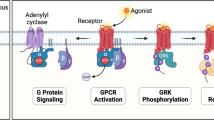Abstract
Adenosine triphosphate (ATP) is an ancient and fundamentally important biological molecule involved in both intracellular and extracellular activities. P2X ionotropic and P2Y metabotropic receptors have been cloned and characterised in mammals. ATP plays a central physiological role as a transmitter molecule in processes including the sensation of pain, taste, breathing and inflammation via the activation of P2X receptors. P2X receptors are structurally distinct from glutamate and Cys-loop/nicotinic receptors and form the third major class of ligand-gated ion channel. Yet, despite the importance of P2X receptors, both as physiological mediators and therapeutic targets, the evolutionary origins and phylogenicity of ATP signalling via P2X receptors remain unclear.

Similar content being viewed by others
Abbreviations
- LGICs:
-
Ligand-gated ion channels
- ESTs:
-
Expressed sequence tags
References
North RA (2002) Molecular physiology of P2X receptors. Physiol Rev 82:1013–1067
Murrell-Lagnado RD, Qureshi OS (2008) Assembly and trafficking of P2X purinergic receptors. Mol Membr Biol 25:321–331. doi:10.1080/09687680802050385
Jasti J, Furukawa H, Gonzales EB et al (2007) Structure of acid-sensing ion channel 1 at 1.9 A resolution and low pH. Nature 449:316–323. doi:10.1038/nature06163
Yazawa M, Ferrante C, Feng J et al (2007) TRIC channels are essential for Ca2+ handling in intracellular stores. Nature 448:78–82. doi:10.1038/nature05928
Brake AJ, Wagenbach MJ, Julius D (1994) New structural motif for ligand-gated ion channels defined by an ionotropic ATP receptor. Nature 371:519–523. doi:10.1038/371519a0
Valera S, Hussy N, Evans RJ et al (1994) A new class of ligand-gated ion channel defined by P2X receptor for extra-cellular ATP. Nature 371:516–519. doi:10.1038/371516a0
Burnstock G, Knight GE (2004) Cellular distribution and functions of P2 receptor subtypes in different systems. Int Rev Cytol 240:31–304. doi:10.1016/S0074-7696(04)40002-3
Trams EG (1981) On the evolution of neurochemical transmission. Differentiation 19:125–133. doi:10.1111/j.1432-0436.1981.tb01140.x
Eichinger L, Pachebat JA, Glockner G et al (2005) The genome of the social amoeba Dictyostelium discoideum. Nature 435:43–57. doi:10.1038/nature03481
Derelle E, Ferraz C, Rombauts S et al (2006) Genome analysis of the smallest free-living eukaryote Ostreococcus tauri unveils many unique features. Proc Natl Acad Sci U S A 103:11647–11652. doi:10.1073/pnas.0604795103
King N, Westbrook MJ, Young SL et al (2008) The genome of the choanoflagellate Monosiga brevicollis and the origin of metazoans. Nature 451:783–788. doi:10.1038/nature06617
Srivastava M, Begovic E, Chapman J et al (2008) The Trichoplax genome and the nature of placozoans. Nature 454:955–960. doi:10.1038/nature07191
Burnstock G (2007) Physiology and pathophysiology of purinergic neurotransmission. Physiol Rev 87:659–797. doi:10.1152/physrev.00043.2006
Burnstock G (1996) Purinoceptors: ontogeny and phylogeny. Drug Dev Res 39:204–242. doi:10.1002/(SICI)1098-2299(199611/12)39:3/4<204::AID-DDR2>3.0.CO;2-V
Agboh KC, Webb TE, Evans RJ et al (2004) Functional characterization of a P2X receptor from Schistosoma mansoni. J Biol Chem 279:41650–41657. doi:10.1074/jbc.M408203200
Brockie PJ, Mellem JE, Hills T et al (2001) The C. elegans glutamate receptor subunit NMR-1 is required for slow NMDA-activated currents that regulate reversal frequency during locomotion. Neuron 31:617–630. doi:10.1016/S0896-6273(01)00394-4
Jones AK, Sattelle DB (2008) The cys-loop ligand-gated ion channel gene superfamily of the nematode, Caenorhabditis elegans. Invert Neurosci 8:41–47. doi:10.1007/s10158-008-0068-4
Finger TE, Danilova V, Barrows J et al (2005) ATP signaling is crucial for communication from taste buds to gustatory nerves. Science 310:1495–1499. doi:10.1126/science.1118435
Fountain SJ, Cao L, Young MT et al (2008) Permeation properties of a P2X receptor in the green algae Ostreococcus tauri. J Biol Chem 283:15122–15126. doi:10.1074/jbc.M801512200
Fountain SJ, Parkinson K, Young MT et al (2007) An intracellular P2X receptor required for osmoregulation in Dictyostelium discoideum. Nature 448:200–203. doi:10.1038/nature05926
Ludlow MJ, Traynor D, Fisher PR et al (2008) Purinergic-mediated Ca2+ influx in Dictyostelium discoideum. Cell Calcium 44:567–579. doi:10.1016/j.ceca.2008.04.001
Kim SY, Sivaguru M, Stacey G (2006) Extracellular ATP in plants. Visualization, localization, and analysis of physiological significance in growth and signaling. Plant Physiol 142:984–992. doi:10.1104/pp.106.085670
Roux SJ, Steinebrunner I (2007) Extracellular ATP: an unexpected role as a signaler in plants. Trends Plant Sci 12:522–527. doi:10.1016/j.tplants.2007.09.003
Chen GQ, Cui C, Mayer ML et al (1999) Functional characterization of a potassium-selective prokaryotic glutamate receptor. Nature 402:817–821. doi:10.1038/990080
Author information
Authors and Affiliations
Corresponding author
Additional information
Bioinformatic information was retrieved using BLAST searches of the National Center for Biotechnology Information (NCBI) and DOE Joint Genome Institute databases. SJF is supported by a BBSRC David Phillips Fellowship.




